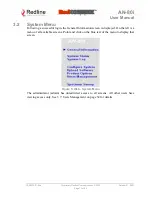
Red
CONNEX
TM
AN-80i
User
Manual
70-00072-01-04b
Proprietary Redline Communications © 2007
October 31, 2007
Page 31 of 94
DFS Action
: Select the mode of operation for DFS.
The system set to PTP Master monitors for interference from radar devices and other
equipment using the same channel frequency. When interference is detected, the system
automatically takes the action selected using the drop-down menu.
None
: The DFS function is disabled.
Tx Off
: Transmission is disabled when radar signals are detected. This action is
recorded in the message log and an SNMP trap message is sent (if SNMP enabled).
Following an interval of thirty minutes, the same channel is monitored for one minute
and if there are no DFS triggering events, the system resumes normal operation. If
DFS trigger conditions are still detected, operation is suspended for an additional
thirty minutes. This cycle continues until no DFS trigger events are detected or the
operator manually reconfigures the system.
Chg Freq
: Relocate transmission to an alternative frequency immediately when radar
signals are detected. This action is recorded in the message log and a trap message is
sent (if SNMP enabled).
The new channel is selected based on allowable frequencies for the regulatory region
of that installation. The channel is monitored for one minute before the system is
allowed to transmit. If DFS triggering events are detected, the next available channel
is selected and monitored. The system is not allowed to return to a channel on
which DFS trigger events were detected for a period of thirty minutes. If DFS trigger
events are detected on all channels, operation is suspended until the thirty-minute
time interval expires for at least one channel.
Important
:
Where DFS is required by regional regulations, this function is
permanently enabled at the factory and can not be disabled by the installer or end-user.
Antenna Gain
: Enter the gain (dBm) for the system antenna.
It is important that the Antenna Gain setting matches the actual antenna gain. If the
antenna gain is set higher than the true antenna gain, the system is less sensitive to
detecting interference, and is not operating in compliance with the UK/ETSI standard. If
the antenna gain is set lower than the true antenna gain, the system is more sensitive to
interference and this may result in false DFS triggers.
ATPC Enable
: Check this box to enable the AN-80i to monitor the received signal
and request that the remote system adjustment its transmit level for optimum
performance. The ATPC feature must be enabled on both AN-80i units.
Important: When ATPC is enabled, best results are obtained by enabling adaptive
modulation.
Adaptive Modulation
: Check this box to enable the AN-80i to automatically adjust
the transmission modulation and code settings to achieve the highest UBR that will
operate with a packet error rate (PER at layer 2) of less than 1x10e-6. If the PER exceeds
1x10e-6, the AN-80i automatically adjusts the modulation and code settings downwards
(i.e., from 16 QAM 3/4 to 16 QAM 1/2) to operate at a lower UBR where the PER is
acceptable. When disabled, the modulation and code settings are entered manually using
the Uncoded Burst Rate setting. See Table 4
:
Web - Max. Power (in dBm) and
Modulation.















































